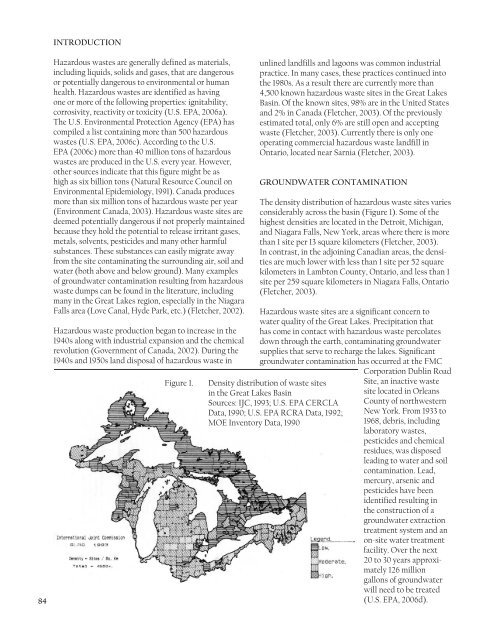Groundwater in the Great Lakes Basin
Groundwater in the Great Lakes Basin
Groundwater in the Great Lakes Basin
You also want an ePaper? Increase the reach of your titles
YUMPU automatically turns print PDFs into web optimized ePapers that Google loves.
INTRODUCTION<br />
84<br />
Hazardous wastes are generally def<strong>in</strong>ed as materials,<br />
<strong>in</strong>clud<strong>in</strong>g liquids, solids and gases, that are dangerous<br />
or potentially dangerous to environmental or human<br />
health. Hazardous wastes are identified as hav<strong>in</strong>g<br />
one or more of <strong>the</strong> follow<strong>in</strong>g properties: ignitability,<br />
corrosivity, reactivity or toxicity (U.S. EPA, 2006a).<br />
The U.S. Environmental Protection Agency (EPA) has<br />
compiled a list conta<strong>in</strong><strong>in</strong>g more than 500 hazardous<br />
wastes (U.S. EPA, 2006c). Accord<strong>in</strong>g to <strong>the</strong> U.S.<br />
EPA (2006c) more than 40 million tons of hazardous<br />
wastes are produced <strong>in</strong> <strong>the</strong> U.S. every year. However,<br />
o<strong>the</strong>r sources <strong>in</strong>dicate that this figure might be as<br />
high as six billion tons (Natural Resource Council on<br />
Environmental Epidemiology, 1991). Canada produces<br />
more than six million tons of hazardous waste per year<br />
(Environment Canada, 2003). Hazardous waste sites are<br />
deemed potentially dangerous if not properly ma<strong>in</strong>ta<strong>in</strong>ed<br />
because <strong>the</strong>y hold <strong>the</strong> potential to release irritant gases,<br />
metals, solvents, pesticides and many o<strong>the</strong>r harmful<br />
substances. These substances can easily migrate away<br />
from <strong>the</strong> site contam<strong>in</strong>at<strong>in</strong>g <strong>the</strong> surround<strong>in</strong>g air, soil and<br />
water (both above and below ground). Many examples<br />
of groundwater contam<strong>in</strong>ation result<strong>in</strong>g from hazardous<br />
waste dumps can be found <strong>in</strong> <strong>the</strong> literature, <strong>in</strong>clud<strong>in</strong>g<br />
many <strong>in</strong> <strong>the</strong> <strong>Great</strong> <strong>Lakes</strong> region, especially <strong>in</strong> <strong>the</strong> Niagara<br />
Falls area (Love Canal, Hyde Park, etc.) (Fletcher, 2002).<br />
Hazardous waste production began to <strong>in</strong>crease <strong>in</strong> <strong>the</strong><br />
1940s along with <strong>in</strong>dustrial expansion and <strong>the</strong> chemical<br />
revolution (Government of Canada, 2002). Dur<strong>in</strong>g <strong>the</strong><br />
1940s and 1950s land disposal of hazardous waste <strong>in</strong><br />
Figure 1.<br />
unl<strong>in</strong>ed landfills and lagoons was common <strong>in</strong>dustrial<br />
practice. In many cases, <strong>the</strong>se practices cont<strong>in</strong>ued <strong>in</strong>to<br />
<strong>the</strong> 1980s. As a result <strong>the</strong>re are currently more than<br />
4,500 known hazardous waste sites <strong>in</strong> <strong>the</strong> <strong>Great</strong> <strong>Lakes</strong><br />
Bas<strong>in</strong>. Of <strong>the</strong> known sites, 98% are <strong>in</strong> <strong>the</strong> United States<br />
and 2% <strong>in</strong> Canada (Fletcher, 2003). Of <strong>the</strong> previously<br />
estimated total, only 6% are still open and accept<strong>in</strong>g<br />
waste (Fletcher, 2003). Currently <strong>the</strong>re is only one<br />
operat<strong>in</strong>g commercial hazardous waste landfill <strong>in</strong><br />
Ontario, located near Sarnia (Fletcher, 2003).<br />
GROUNDWATER CONTAMINATION<br />
The density distribution of hazardous waste sites varies<br />
considerably across <strong>the</strong> bas<strong>in</strong> (Figure 1). Some of <strong>the</strong><br />
highest densities are located <strong>in</strong> <strong>the</strong> Detroit, Michigan,<br />
and Niagara Falls, New York, areas where <strong>the</strong>re is more<br />
than 1 site per 13 square kilometers (Fletcher, 2003).<br />
In contrast, <strong>in</strong> <strong>the</strong> adjo<strong>in</strong><strong>in</strong>g Canadian areas, <strong>the</strong> densities<br />
are much lower with less than 1 site per 52 square<br />
kilometers <strong>in</strong> Lambton County, Ontario, and less than 1<br />
site per 259 square kilometers <strong>in</strong> Niagara Falls, Ontario<br />
(Fletcher, 2003).<br />
Hazardous waste sites are a significant concern to<br />
water quality of <strong>the</strong> <strong>Great</strong> <strong>Lakes</strong>. Precipitation that<br />
has come <strong>in</strong> contact with hazardous waste percolates<br />
down through <strong>the</strong> earth, contam<strong>in</strong>at<strong>in</strong>g groundwater<br />
supplies that serve to recharge <strong>the</strong> lakes. Significant<br />
groundwater contam<strong>in</strong>ation has occurred at <strong>the</strong> FMC<br />
Density distribution of waste sites<br />
<strong>in</strong> <strong>the</strong> <strong>Great</strong> <strong>Lakes</strong> Bas<strong>in</strong><br />
Sources: IJC, 1993; U.S. EPA CERCLA<br />
Data, 1990; U.S. EPA RCRA Data, 1992;<br />
MOE Inventory Data, 1990<br />
Corporation Dubl<strong>in</strong> Road<br />
Site, an <strong>in</strong>active waste<br />
site located <strong>in</strong> Orleans<br />
County of northwestern<br />
New York. From 1933 to<br />
1968, debris, <strong>in</strong>clud<strong>in</strong>g<br />
laboratory wastes,<br />
pesticides and chemical<br />
residues, was disposed<br />
lead<strong>in</strong>g to water and soil<br />
contam<strong>in</strong>ation. Lead,<br />
mercury, arsenic and<br />
pesticides have been<br />
identified result<strong>in</strong>g <strong>in</strong><br />
<strong>the</strong> construction of a<br />
groundwater extraction<br />
treatment system and an<br />
on-site water treatment<br />
facility. Over <strong>the</strong> next<br />
20 to 30 years approximately<br />
126 million<br />
gallons of groundwater<br />
will need to be treated<br />
(U.S. EPA, 2006d).

















